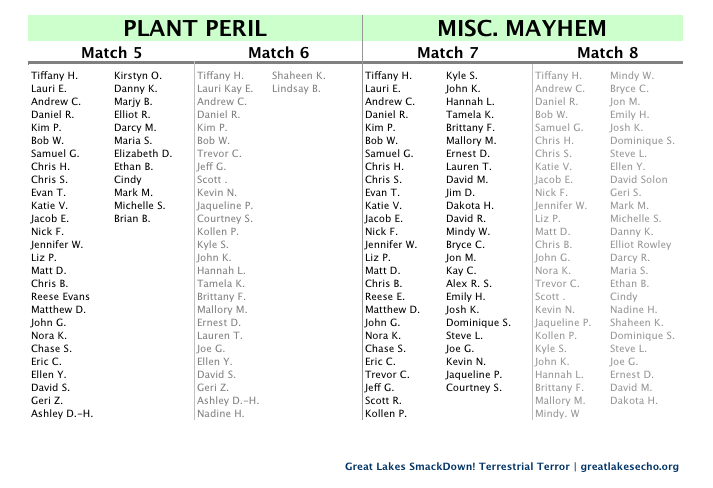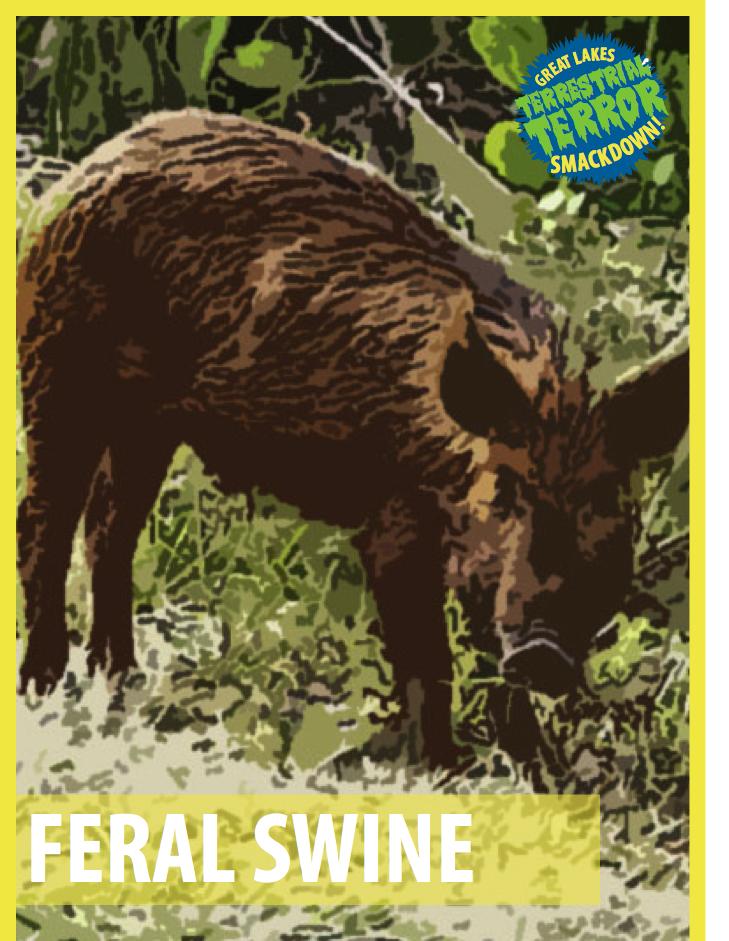By Alice Rossignol and Rachael Gleason
Editors note: Great Lakes SmackDown! Terrestrial Terror is an ongoing Great Lakes Echo series.
PLANT PERIL
Match 5: Purple Loosestrife vs. Garlic Mustard
So now to solve the mystery: Was it Colonel Mustard in the forest with the pistil, or the Purple Plague in the swamps with the stamen?
 A criminal invasive has been chosen to move on to Round 2. And it’s Colonel Mustard!
A criminal invasive has been chosen to move on to Round 2. And it’s Colonel Mustard!
Fifty-eight percent of pollsters chose the Garlic Mustard; 53 percent of bracketeers agreed.
And expert opinion seems to support reader claims.
“In Wisconsin, Purple Loosestrife has been under biological control for 12 to 15 years, it’s not nearly as impactful as it has once been,” said Tom Boos, forestry invasive plant coordinator of the Wisconsin Department of Natural Resources.
A biological control, an insect called the galerucella, is a successful control of the plant.
“And so, from an impact standpoint, it’s less than it has been because of its biological control,” he said.
Keeping the Colonel under control is the bitterer battle.
“Garlic mustard is very, very bad,” Boos said.
“It’s the most widespread forest, herbaceous invasive plant in the state. And it basically just covers the ground layer and it doesn’t allow anything else to grow through it,” he said.
Garlic mustard has a two-pronged attack, suffocating plants from above and dominating root systems from below.
“They’re not just drowning [native plants] out,” Boos said. “They’re getting them from below the ground as well and then it spreads so quickly.”
Match 6: Spotted Knapweed vs. Beech Scale
The Knapster and The Bark Butcher went plant-to-insect in an inter-kingdom smackdown.
 Sixty-one percent of bracketeers and 60 percent of pollsters chose the spotted knapweed to move on to the next round.
Sixty-one percent of bracketeers and 60 percent of pollsters chose the spotted knapweed to move on to the next round.
But here at Echo we beg to differ. From talking to experts and doing our own research, we’re going with the underdog for the win: The beech scale.
The perilous insect only earned 38 percent of your votes in the brackets and 40 percent in the polls, but it deserves to move to Round 2. And here’s why:
The beech scale teams up with a fungus to cause a disease that feeds on beech trees.
“The beech bark disease complex – it can take away your trees pretty quick,” said Andrew Diss-Torrance of the Wisconsin Department of Natural Resources.
Beech trees are a mast crop, meaning that it’s ecologically and economically valuable because it produces a lot of nuts and is a favored food source for animals.
The spotted knapweed is still a bad guy to be sure; the plant is pervasive.
“It just grows like wildfire, they grow densely and they grow a lot of seed,” Boos said.
The plant, originally from Europe, is known to take over ditches, dunes, and recovering farm and pasture land.
“I mean it’s just a convenience factor and there’s just so much of it in certain areas you just know that your bees are going to be happy,” Boos said.
But the beech scale’s sidekick fungus makes it victorious.
MISCELLANEOUS MAYHEM
Match 7: Feral Swine vs. Giant Hogweed
Last week The Beast and The Hulk took to the ring to prove which species was the true heavyweight.
 Seventy-one percent of bracketeers and 76 percent of pollsters dubbed the feral swine the heavy weight champ!
Seventy-one percent of bracketeers and 76 percent of pollsters dubbed the feral swine the heavy weight champ!
Feral swine are present in at least 44 states and cause more than $8 million of damage annually, said Michelle Rosen, a laboratory technician of the Michigan Department of Natural Resources.
Michigan’s population is between three and five thousand, she said.
They’re also known to carry up to 30 bacterial and viral diseases and up to 37 parasites, which have the potential to sicken other wildlife and even people.
Its formidable opponent, the giant hogweed, measures in up to 20 feet high.
This plant can give humans rashes and even cause blindness if it comes in contact with your eyes.
“Because this thing is so big … people go out there and start whacking at it with a … sickle or whatever and kill it,” Boos said. “And you just see horror stories because they had to go to the hospital [because they] went to cut their weeds with shorts and flip flops.”
But even with its large presence it was no match for the feral swine, which reportedly also kill baby deer. Bambi would be ashamed and so are we.
Match 8: European Valve Snail vs. Chinese and Japanese Mystery Snails
The Terrestrial Terror’s two aquatic wildcards went shell-to-shell last week in the final match of Round 1.
 There’s no mystery about it, and nearly every bracketeer agreed: The Chinese and Japanese Mystery Snail Tagteam overshadowed the European Spiral of Doom.
There’s no mystery about it, and nearly every bracketeer agreed: The Chinese and Japanese Mystery Snail Tagteam overshadowed the European Spiral of Doom.
But it’s not because the match was two against one; the mystery snails are also significantly larger. Their rotting bodies leave a trail of stink along beaches.
Valve snail shells are only about five millimeters or one fifth of an inch. Mystery snail shells are an order of magnitude larger, said Robert Dillon, associate professor of biology at the College of Charleston in South Carolina. Dillon is an avid researcher of the genetics, evolution and ecology of mollusks.
The mouths of the mystery snails are so large, even at birth, that they could easily stuff the tiny Valve snails inside and eat them, he said.
“There’s no contest between the mystery snail and [valve snail],” Dillon said.
A gap in research makes it difficult to understand the impact of these species in North America, he said. There are three native valve snail species on this continent. But there are no native mystery snails; their arrival might have filled a niche, making their presence more difficult to detect.
One way the mystery snails make their presence known is by washing up dead on beaches and stinking to the high heavens.
In the Carolinas, deceased mystery snails often plague waterfront homeowners, Dillon said. They ask: “What are these dead and rotting snails washing up on the boat dock?”
“In Virginia, along the Potomac River south of Washington, just last year they had to bring bull dozers in to get them out,” Dillon said.
That makes the mystery snails more a problem to humans, all the way from South Carolina to the Great Lakes.
“People will notice the mystery snails,” he said. “You would never even see valvata.”
INVASIVE TERRORS ADVANCING TO SMACKDOWN! ROUND 2
- Mute Swan “The Silent Foul”
- The European Starling “Shakespeare’s Darling”
- Emerald Ash Borer “The Green Menace”
- Gypsy Moth “The Extreme Defoliator”
- Garlic Mustard “Colonel Mustard”
- Beech Scale “The Bark Butcher”
- Feral Swine “The Beast”
- Chinese and Japanese Mystery Snails “Tagteam”
Congratulations to the following brackeeters for correctly calling the matches:

